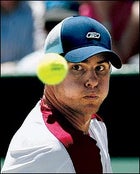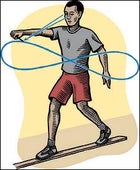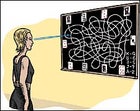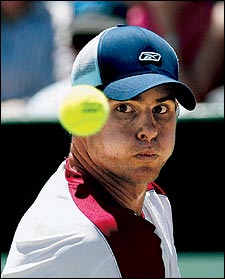MANY OF US DO LITTLE MORE to keep our eyes in shape than roll them at Bill O’Reilly. But proper eye function can make or break your day: It allows you to return a 100-mile-an-hour tennis serve, hold the best line through a mogul run, and keep your balance while hiking a steep trail. For most people, nothing short of surgery will return 20/20 eyesight, but the growing field of sports-vision research can help fine-tune and flex the nine muscles that power your peepers—the three inside the eye that help you focus, and the six outside it, which control direction and scan. It’s worth the effort: Vision training improves balance, peripheral vision, recognition speed, and reflexes.
Andy Roddick
 Sight club: Tennis pro Andy Roddick’s orbs are off the charts.
Sight club: Tennis pro Andy Roddick’s orbs are off the charts.
Not surprisingly, the brain plays a major role in all this. In stressful situations—like running Class V rapids or riding a snowboard through trees—peripheral vision goes haywire, taking depth perception and speed with it. This also causes a breakdown in the vestibular system, the part of the brain that handles balance. Essentially, when the eyes get too much alarming information at once, short-circuiting is one of the body’s defense mechanisms: Visual information that should pass through this system instead rushes straight to the brain cells in charge of sparking your motor skills and thus your reflexes.
“Your vision system practically shuts down,” says Burton Worrell, 61, a San Jose, California–based optometrist who, among other things, has helped batters on the San Francisco Giants do a better job picking up on the spin of a curveball.
Fortunately, you can learn to tap right back in to that data pipeline. Worrell’s latest ocular regimen (see ““) grew out of his groundbreaking research with college baseball teams, including the University of California–Berkeley. Over a 12-week period, players who practiced Worrell’s vision drills improved their batting averages by 43 points—an increase that can spell the difference between a minor-league player and a major leaguer. Since then, Worrell has helped members of the UC Berkeley ski team—plus a number of Santa Cruz–based surfers—sharpen their focus, and he’s now working with big-league umpires to help them call balls and strikes more accurately. His system, which involves creating optical tests that challenge eye speed and visual acuity, can work for anyone who needs to keep an eye on the prize.
Rapid Eye Movement
Ocular Drills: Improving Balance & Staying Focused
Workouts for Your Eyes
 Illustration by Gregory Nemec
Illustration by Gregory NemecWorkouts for Your Eyes
 Illustration by Gregory Nemec
Illustration by Gregory NemecBurton Worrell’s ocular drills are designed to improve your visual recognition, focus, and reaction skills. Spend three minutes on each of the four exercises shown here. If you feel like you want to quit before that, don’t. You’re building visual stamina, a critical but overlooked skill for optically intense endeavors like downhill mountain biking or searching for handholds on a granite face.
Walk the Plank
The Challenge: When you’re multitasking at full tilt, balance is one of the first things to suffer. Forcing yourself to focus on a moving object throughout your line of sight—while you’re moving and keeping your balance—trains you to maintain your inner equilibrium.
The Drill: Lay a two-by-four flat on the floor and stand on it with one foot in front of the other. Pick up a pen that has text printed on the side and, with your arm fully extended, lift it to eye level. Make wide, sweeping figure eights with your arm and, moving only your eyes, stay focused on the letters on the pen. Finally, walk forward and backwards on the beam while continuing the figure eights.
Connect the Cards
The Challenge: One of the trickiest aspects of most sports is staying focused when everything is moving around you. Think of a wide receiver in football: He has to concentrate on the ball while he and the other players around him are in motion—a situation that easily overtaxes the brain. Skiers face the same task when speeding down a line on a crowded slope.
The Drill: Tape ten playing cards around the border of a four-by-six-foot chalkboard. Draw a complex, twisting path between two of the cards. In a corner of the board, write down which two are connected by the line you just drew. Repeat with the remaining cards so that the board is a jumble of chalk lines that connect the cards in pairs. Standing seven feet from the board, start at one of the cards and follow the route as quickly as possible, moving only your eyes. Check your answer key to ensure you picked the right path.


